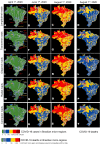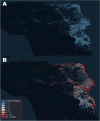The impact of super-spreader cities, highways, and intensive care availability in the early stages of the COVID-19 epidemic in Brazil
- PMID: 34155241
- PMCID: PMC8217556
- DOI: 10.1038/s41598-021-92263-3
The impact of super-spreader cities, highways, and intensive care availability in the early stages of the COVID-19 epidemic in Brazil
Abstract
Although international airports served as main entry points for SARS-CoV-2, the factors driving the uneven geographic spread of COVID-19 cases and deaths in Brazil remain mostly unknown. Here we show that three major factors influenced the early macro-geographical dynamics of COVID-19 in Brazil. Mathematical modeling revealed that the "super-spreading city" of São Paulo initially accounted for more than 85% of the case spread in the entire country. By adding only 16 other spreading cities, we accounted for 98-99% of the cases reported during the first 3 months of the pandemic in Brazil. Moreover, 26 federal highways accounted for about 30% of SARS-CoV-2's case spread. As cases increased in the Brazilian interior, the distribution of COVID-19 deaths began to correlate with the allocation of the country's intensive care units (ICUs), which is heavily weighted towards state capitals. Thus, severely ill patients living in the countryside had to be transported to state capitals to access ICU beds, creating a "boomerang effect" that contributed to skew the distribution of COVID-19 deaths. Therefore, if (i) a lockdown had been imposed earlier on in spreader-capitals, (ii) mandatory road traffic restrictions had been enforced, and (iii) a more equitable geographic distribution of ICU beds existed, the impact of COVID-19 in Brazil would be significantly lower.
Conflict of interest statement
The authors declare no competing interests.
Figures




References
-
- Coronavirus Resource Center. "COVID-19 Dashboard by the Center for Systems Science and Engineering (CSSE) at Johns Hopkins University (JHU)." John Hopkins University & Medicine (2020). https://coronavirus.jhu.edu/map.html (2020).
Publication types
MeSH terms
LinkOut - more resources
Full Text Sources
Medical
Research Materials
Miscellaneous

